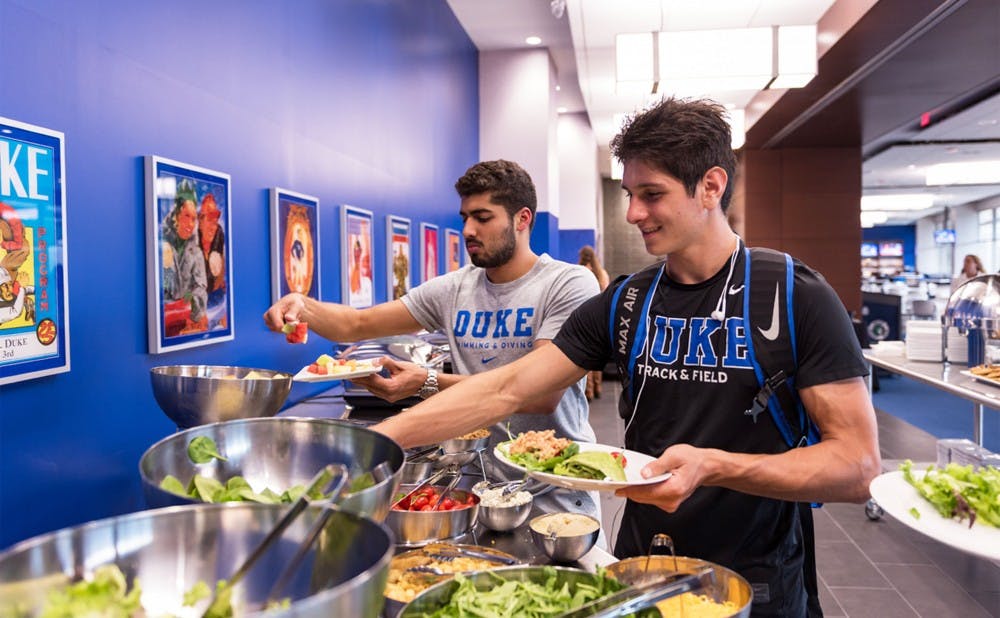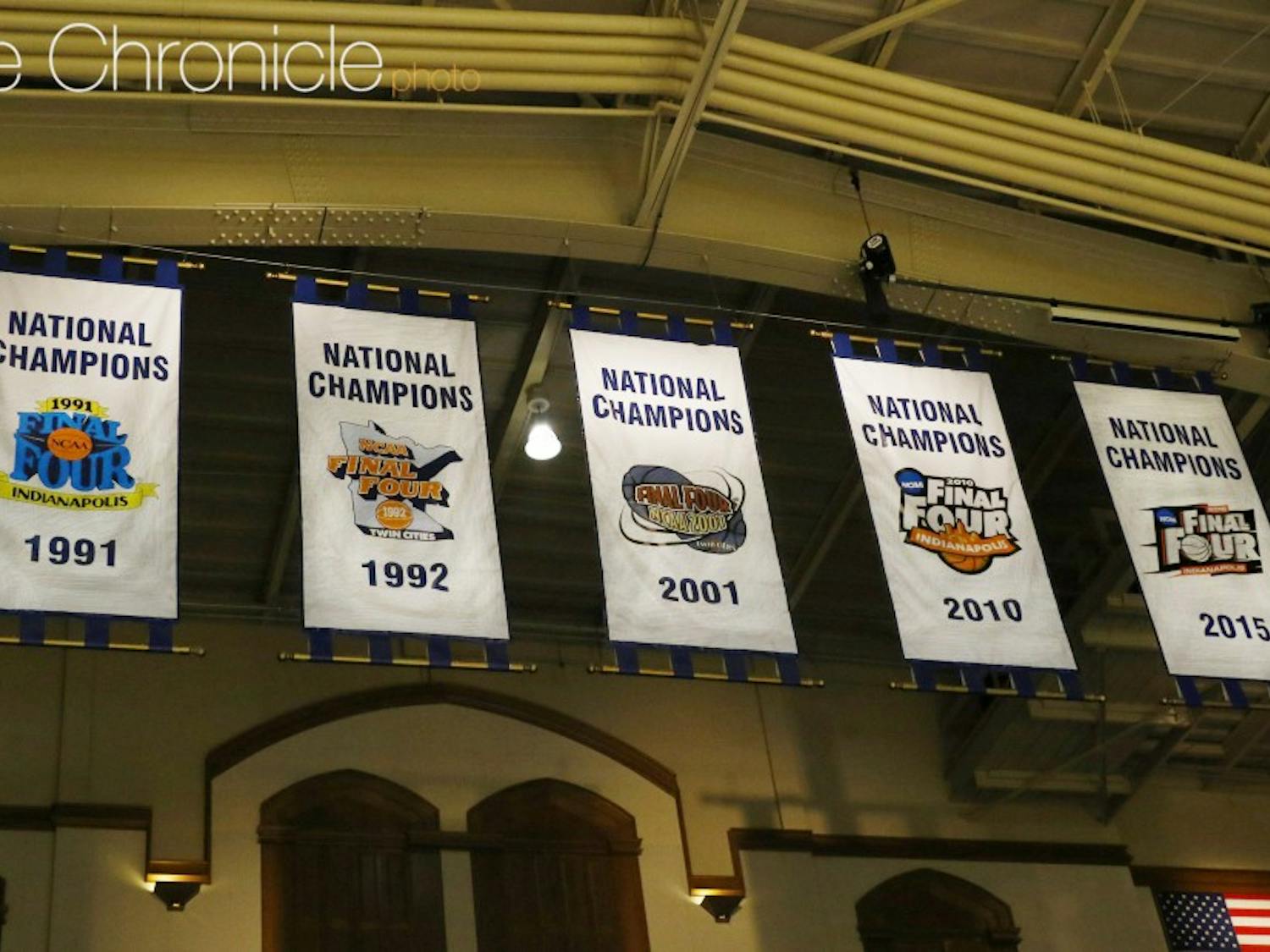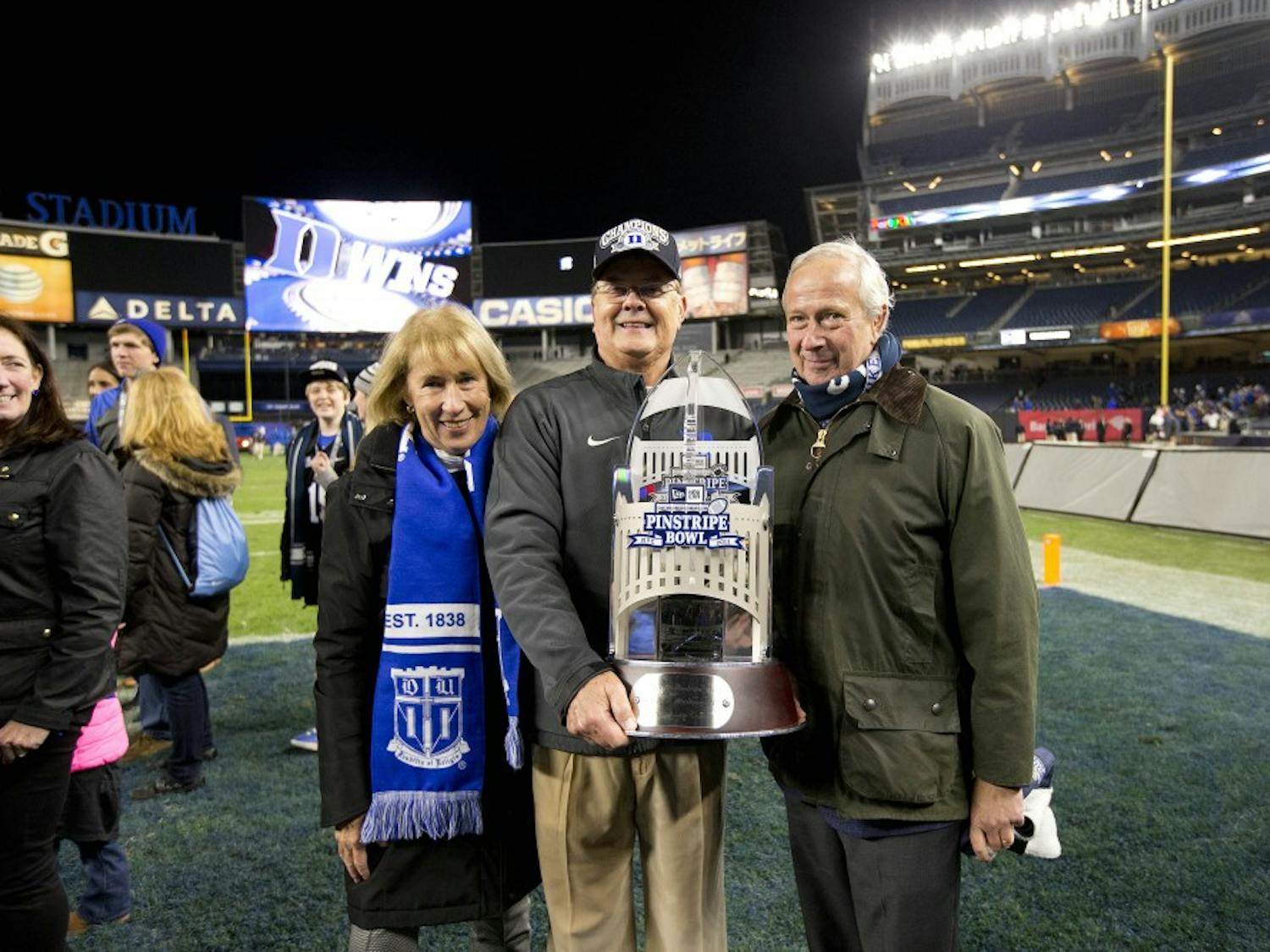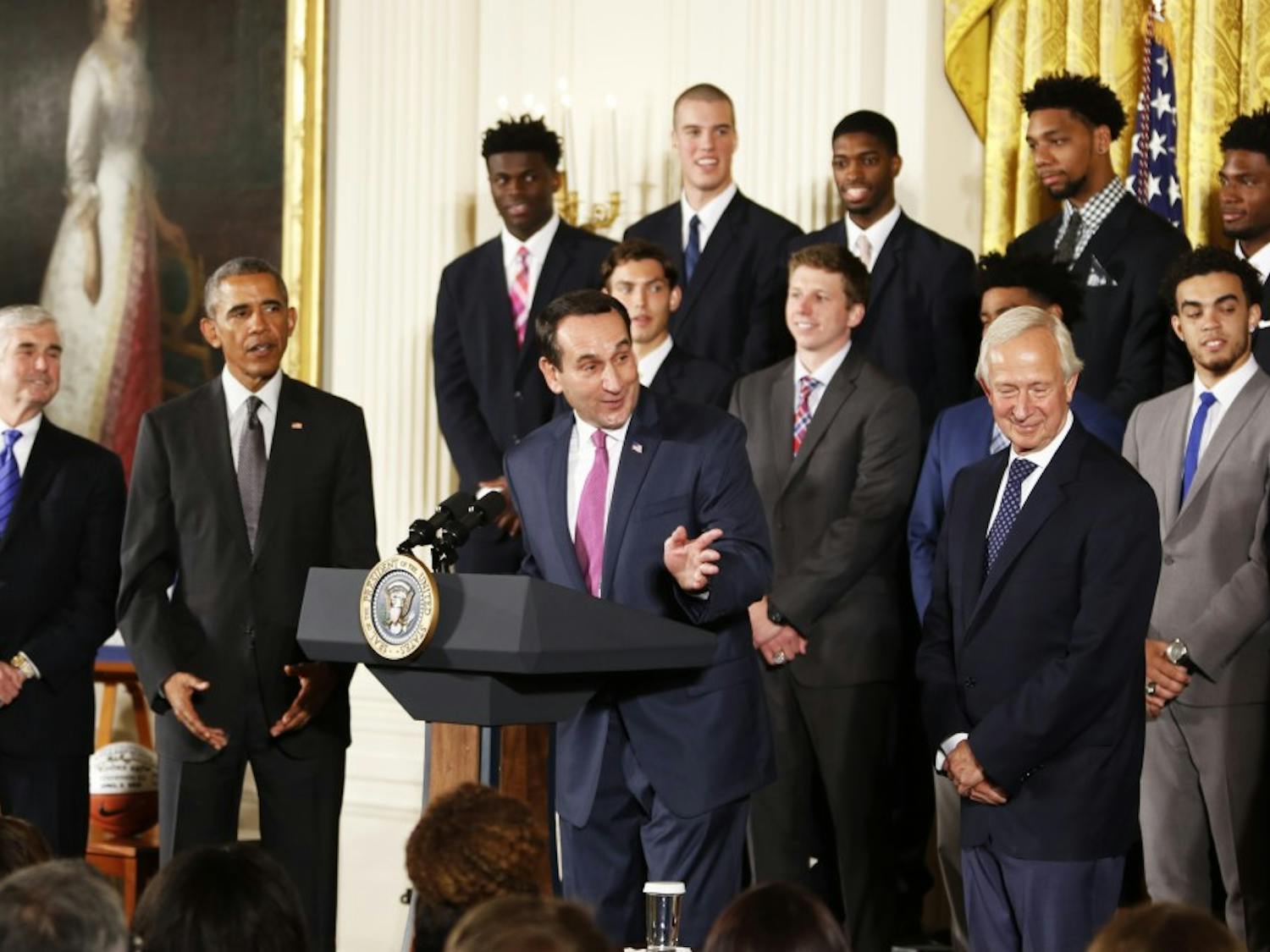During the 2014-15 season, Duke head coach Mike Krzyzewski coined the phrase “Eight is enough” to describe the Blue Devils’ championship run driven by eight players in the team’s rotation.
But eight was not nearly enough to count the number of post-practice recovery smoothies the team consumed on a regular basis. Duke got in the habit of tweeting pictures of its smoothies throughout the season, with one photo showing at least 24 smoothies with five different flavors for the Blue Devils to refuel. Part of the team’s nutrition room includes an iPad that displays various recipes for Gatorade recovery shakes.
On the football field, head coach David Cutcliffe and company have also prioritized nutrition, switching their caterer in Fall 2015 and dubbing this season the “year of the beast.”
The emphasis on nutrition at Duke is part of a nationwide trend. After Connecticut guard Shabazz Napier won the national championship in April 2014, he said that he sometimes went to bed “starving” because he couldn’t afford food. A week later, the NCAA ruled that teams could provide unlimited food—a decision that had been recommended long before Napier’s comments—kicking off what has been dubbed “the next arms race in major sports” by The New York Times.
“The world has finally gotten the message of how important food really is,” said Franca Alphin, Duke’s director of nutrition services for student health who also oversees athletes’ nutrition.
‘They’d have no points’
In September 2015, the Collegiate and Professional Sports Dietitians Association reported that major college athletic programs on average more than doubled their nutrition spending from $534,000 to $1.3 million following the NCAA’s decision.
Duke athletics spokesman Art Chase declined to provide the department’s specific budget for nutrition but acknowledged that it is spending more on nutrition than it did in years past.
Last week, the University opened its first buffet-style training table for dinner that is available to all 26 varsity sports in the new Blue Devil Tower, which houses Wallace Wade Stadium’s press box and executive suites. Training table was previously only an option for men’s basketball and football, Alphin said, adding that one of the biggest results of the NCAA’s rule change is that teams can also provide snacks throughout the day and not just at meal times.
“Now they have access to more food. You might say why does that make a difference? Because a lot of the athletes would come in here and I would talk to them, and they would be out of [food] points,” Alphin said. “They’d have no points, they would literally rely on friends to order food for them and I’d be educating them on how they should eat and what they should eat, and they’re like, ‘I have no money.’ That’s really hard to do sports nutrition education.”
Despite the increased importance of athletes’ nutrition, according to the September 2015 CPSDA report, there were only 53 full-time college sports dietitians in the country—about one for every 9,000 NCAA athletes.
Because of Alphin’s other responsibilities at the University, she is not considered a full-time sports dietitian. She noted that many schools use a combination of full-time, part-time and contract dietitians, adding that fellow ACC schools like Virginia Tech and North Carolina have three sports dietitians. Alphin said that Duke could use more dietitians focused on sports—she is currently the only one in charge of overseeing nutrition for all approximately 600 Blue Devil athletes.
“From your mouth to God’s ears, I can only hope,” Alphin said. “I do what I can and I love what I do, and I will continue to do that. But certainly as a sports dietitian, my goal would be and I would hope that in the years to come, we’re going to have more support.”
From fencing to food apps
Luckily for Alphin, one Duke athlete has taken the task of educating athletes about nutrition into his own hands.
Senior fencer Joe Lam has worked with Alphin to create a startup called Brainbuild, which syncs athletes’ daily schedules with dietitian recommendations and on-campus food options to notify them of the ideal times to eat during the day and provide specific choices. The company uses Google Calendar and an app to provide timely reminders based on athletes’ schedules, and five schools are already using its product since its spring 2016 launch—Duke, Columbia, Cornell, UC San Diego and Emory.
Athletes across more than 16 sports are currently using it, according to Brainbuild’s website, and Lam noted that multiple other Division I programs are considering adding their athletes to the program.
“[At Duke,] we give one person the role of taking care of something that is so important for all of these athletes,” Lam said. “Who eats more than athletes? Everything in your training is affected by how you treat your body.”
A 20th-place finisher at the 2014 NCAA championship in the foil competition, Lam helped his uncle start a biotech company before coming to Duke. He went through the 500 Startups accelerator program as an employee of another company before realizing he could create his own company to act as a dietitian’s extender.
The San Francisco native did not compete on the fencing team last Spring as he launched Brainbuild, and although he is back training with the fencing team this year, he described the company as his “full-time obligation.”
“There’s no doubt that I’m definitely going to do this after graduate,” Lam said. “I couldn’t see myself do anything else.”
‘More important than working out’
In addition to reminding athletes about the importance of timing with their meals, Brainbuild tries to make nutrition education more accessible and explain the importance of nutrient combinations—for example the balance between proteins, carbohydrates and fats when an athlete is trying not to gain weight.
Alphin described the overwhelming number of pre- and post-workout options from shakes to bars and other snacks as a “whole new language” for many of the athletes that come to Duke, but noted many athletes that she works with take up cooking and even end up giving her new recipes.
An associate professor in the department of community and family medicine, Alphin does not want athletes counting calories and instead preaches plate balance and eating when most active, a message she tells all students.
Lam said eventually he hopes to make Brainbuild available to the general student population, noting “it’s not just knowing the data, it’s knowing what to do with it that matters.”
“You can use your Jawbone [app], you can use your MyFitnessPal app, you’re still not going to know every calorie,” Alphin said. “Most of you eat the bulk of your food from 5 o’clock on but you’re most active from when you get up during the day. We wonder why we gain weight. Because we’re eating a ton of calories when we’re sedentary rather than eating the calories when we need them.”
That message is perhaps most important in wrestling, a sport in which athletes consistently have to watch their weight.
Senior Alex Belaia-Martiniouk has wrestled at 174 pounds and 184 pounds during his career, but said this year he will likely compete at 197 pounds. The North Olmsted, Ohio, native has used Brainbuild and noted that the consistent notifications and healthy food options made it easier to manage his schedule, which often includes two workouts per day as he practices at about 210 pounds ahead of the team’s season-opening event in November.
“Nutrition is really important. It’s more important than working out,” Belaia-Martiniouk said. “If you want to have good abs, if you want to look good and feel good, you have to have good nutrition. You can work out a lot and without good nutrition, you’re going to gain weight still.”
Senior swimmer Jessie Sutherland echoed Belaia-Martiniouk’s praise of Brainbuild, adding that after going through the company’s pilot program, she is trying to encourage her teammates to try it.
“Knowing the timing is really, really helpful. For swimming, we go horizontal. A lot of sports stay upright,” Sutherland said. “If your stomach is full and you’re going [horizontal], you can feel that, and it’s not pleasant.”
‘Research has finally caught up’
Alphin said she has been able to provide more specific tips recently than she was when she started working with athletics 17 years ago, in large part because nutrition has generated more research interest.
Many of her recommendations and pieces of advice from other dietitians are on Duke’s athletic website, and the University even created a Duke sports nutrition Twitter account in August 2015. Examples of how Alphin has been working more closely with athletes—she said coaches have reached out to her more since spring 2014—include explaining how injured competitors should adjust their diet.
Some of the tips Alphin provides are that whole grains can be anti-inflammatory, protein aids recovery and athletes should not consume as many starches when not exercising as much. She recently put together guidelines for athletes recovering from concussions, noting that the omega-3 fatty acids found in salmon, eggs and nuts could be particularly helpful.
“I didn’t realize how much of a difference eating made on your performance because I never really thought of it as you’re fueling your body,” Sutherland said.
As Brainbuild continues its expansion and schools continue competing for the best athletic dining venues, the NCAA’s latest arms race will likely keep impacting Duke for years to come.
But given the ratio of full-time dietitians to athletes and height of the pay-for-play debate, as NCAA President Mark Emmert noted in a 2015 interview with USA Today, the competition between schools might not be a bad thing.
“We still have a long way to do, but boy we’ve come a long way in the last two years,” Alphin said.




